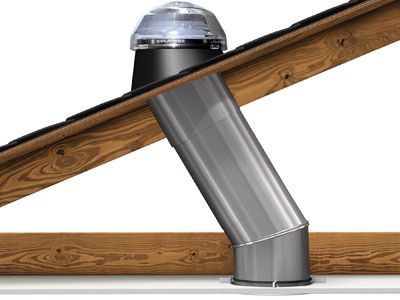Maintaining the Setup
It's not possible to flush-it-and-forget-about-it if you're using a composting toilet, but they can be fairly low-maintenance, depending on the setup. Someone needs to be in charge of the process on an ongoing basis to ensure everything proceeds according to plan. One of the fundamental aspects of maintaining an outhouse with a composting toilet — and the resulting compost piles — is to ensure that conditions are right for successful composting. There are four main variables that need to be monitored and correlated: temperature, moisture, oxygenation and time.
In terms of temperature, the safest way to compost is by creating conditions that allow thermophilic aerobic bacteria to thrive. These helpful bacteria break down the compost, producing heat in the process and allowing the humanure to warm past the temperature where pathogens can survive. This is especially necessary if your compost will be used as fertilizer for food crops. If you go for a low-temperature setup, you'll want to give the compost more time to mature and eventually deposit it on ornamental or unused land, just to be safe.
Advertisement
You'll also need to settle on a material to serve as a carbon-based bulk and make sure it stays well stocked. The point of adding carbon (especially if you do go with a composting toilet that combines urine and feces) is to help nix the nose-offending odor, promote proper composting by increasing the oxygen flow, reduce excess moisture and balance out the levels of nitrogen present in your potty. Then, every time someone uses the composting commode, he or she simply tosses a scoopful of the material down on top to cover it. The substrate can be all or a mixture of particles such as sawdust, peat moss, ashes, straw, hay, leaves or other yard trimmings. And that's really all the involvement needed from anyone who isn't in charge of the management of the compost pile.
For the person who is in the role of compost caretaker, he or she has a few more responsibilities. The compost pile site must be selected (locations well away from groundwater sources are obviously recommended) and enclosures built. A three-bin system works well. First one is filled, then the second is filled while the first is allowed to rest. One to two years is a good period of time for the process to unfold. The central third compartment holds influxes of carbon material that occur throughout the year — say ashes from the fireplace during the winter months and grass clippings from the lawn during the summer. On a regular basis, the person running the show will occasionally need to empty the buckets, flatten out the layers of leavings and ensure everything is being properly covered by the carbon material.
A layer of substrate should be laid down at the start, and then added each time an addition is made. This will trap oxygen within the pile and help increase and regulate the temperature. The lower the temperature the longer it takes to kill any lingering pathogens. One expert on the subject, Joseph Jenkins, recommends keeping the temperature at or above 109.4 degrees Fahrenheit (43 degrees Celsius) for at least one month to ensure complete pathogen destruction [source: Jenkins]. Hotter temperatures can achieve this at a much faster rate. The compost pile won't have completely converted to humus at this point, but any pathogens should be dead. Once the appropriate heating has taken place, it's smart to just let the compost pile rest undisturbed for a year; two to be on the safe side. Additional piles can continue the process in the meantime.
Last but not least, let's cover moisture. The starter material — that which is collected in the composting bucket toilet — is obviously pretty moist. In your compost pile, the little microbes and other small organisms that will break down the humanure into humus need you to strike a balance between moistness and dryness. Basically, it's these micro and macroorganisms the whole process caters to. You want to keep them warm, hydrated, well-fed and with enough oxygen to stay happy and hungry.
Ready to defy the fecophobes and get composting? Get more helpful information below.
Related Articles
- How Toilets Work
- What if Everybody in the U.S. Flushed the Toilet at the Same Time?
- How Green Is a Self-Contained Composting Toilet?
- How Indoor Automatic Composting Systems Work
- What’s the Most Expensive Toilet in the World?
- How Composting Works
- How Vermicomposting Works
- How Sewer and Septic Systems Work
- How Living off the Grid Works
- How the ZeroHouse Works
- How Green Building Works
- Why Can't We Manufacture Water out of Thin Air?
Sources
- "Composting." Decision Maker's Guide to Solid Waste Management, Volume II. EPA. 1995. (Oct. 27, 2011) http://www.epa.gov/osw/conserve/rrr/composting/pubs/chapter7.pdf
- Envirolet. (Oct. 27, 2011) http://compostingtoilet.org/
- Gleick, Peter and Ellis-Lamkins, Phaedra. "Jobs and Water for America." Forbes. Oct. 5, 2011. (Oct. 27, 2011) http://www.forbes.com/sites/petergleick/2011/10/05/jobs-and-water-for-america/
- Griswold, Kent. "How to Make a Composting Toilet." Tiny House Blog. Aug. 19, 2011. (Oct. 27, 2011) http://tinyhouseblog.com/tiny-furnishings/how-to-make-a-composting-toilet/
- Jenkins, Joseph. "Humanure Compost Toilet System Instruction Manual." Humanure Headquarters. (Oct. 27, 2011) http://humanurehandbook.com/manual.html
- Jenkins, Joseph. "The Humanure Handbook." 1999. (Oct. 27, 2011) http://www.weblife.org/humanure/index.html
- "Leading Compost Toilet Information and Advice." CompostJunkie.com. (Oct. 27, 2011) http://www.compostjunkie.com/compost-toilet.htmlMoser, Nick. "Construction of a Composting Toilet." The Shire Institute. Feb. 1, 2008. (Oct. 27, 2011) http://www.the-shire.org/index.php/Eco-Blogs/construction-of-a-composting-toilet.html
- "Water System Audits and Water Loss Control." Delaware River Basin Commission. April 13, 2011. (Oct. 27, 2011) http://www.state.nj.us/drbc/water-audits/overview-najjar.pdf


